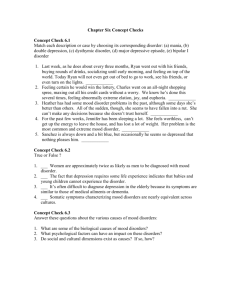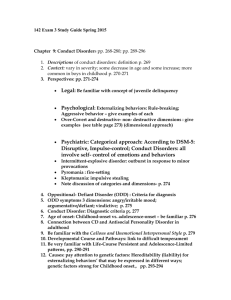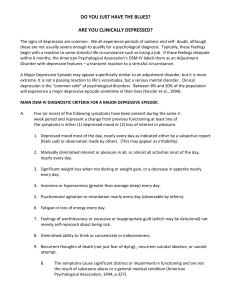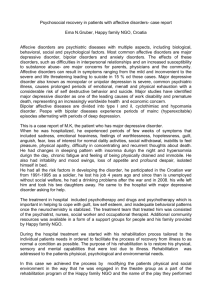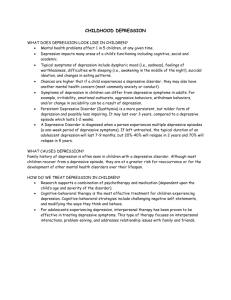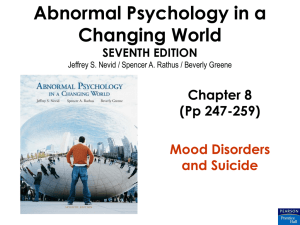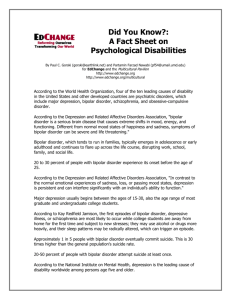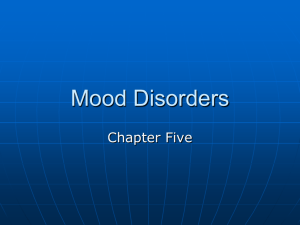ESTIMATING ANXIETY & DEPRESSION
advertisement
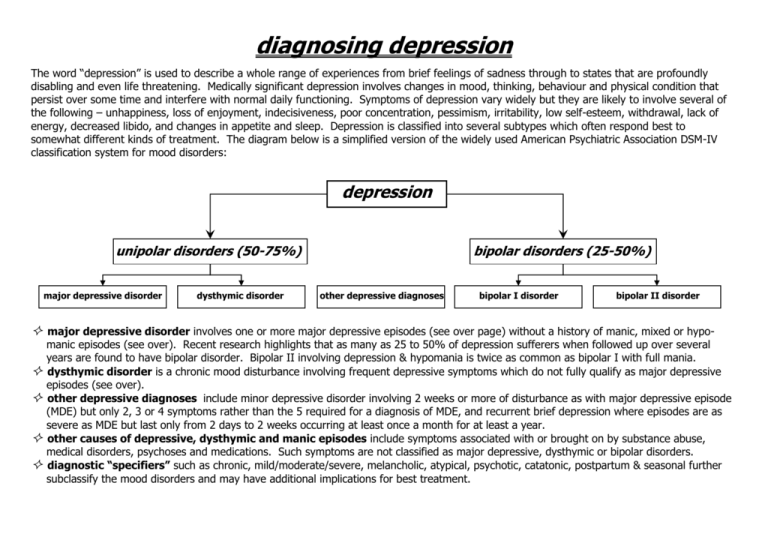
diagnosing depression The word “depression” is used to describe a whole range of experiences from brief feelings of sadness through to states that are profoundly disabling and even life threatening. Medically significant depression involves changes in mood, thinking, behaviour and physical condition that persist over some time and interfere with normal daily functioning. Symptoms of depression vary widely but they are likely to involve several of the following – unhappiness, loss of enjoyment, indecisiveness, poor concentration, pessimism, irritability, low self-esteem, withdrawal, lack of energy, decreased libido, and changes in appetite and sleep. Depression is classified into several subtypes which often respond best to somewhat different kinds of treatment. The diagram below is a simplified version of the widely used American Psychiatric Association DSM-IV classification system for mood disorders: depression unipolar disorders (50-75%) major depressive disorder dysthymic disorder bipolar disorders (25-50%) other depressive diagnoses bipolar I disorder bipolar II disorder major depressive disorder involves one or more major depressive episodes (see over page) without a history of manic, mixed or hypo manic episodes (see over). Recent research highlights that as many as 25 to 50% of depression sufferers when followed up over several years are found to have bipolar disorder. Bipolar II involving depression & hypomania is twice as common as bipolar I with full mania. dysthymic disorder is a chronic mood disturbance involving frequent depressive symptoms which do not fully qualify as major depressive episodes (see over). other depressive diagnoses include minor depressive disorder involving 2 weeks or more of disturbance as with major depressive episode (MDE) but only 2, 3 or 4 symptoms rather than the 5 required for a diagnosis of MDE, and recurrent brief depression where episodes are as severe as MDE but last only from 2 days to 2 weeks occurring at least once a month for at least a year. other causes of depressive, dysthymic and manic episodes include symptoms associated with or brought on by substance abuse, medical disorders, psychoses and medications. Such symptoms are not classified as major depressive, dysthymic or bipolar disorders. diagnostic “specifiers” such as chronic, mild/moderate/severe, melancholic, atypical, psychotic, catatonic, postpartum & seasonal further subclassify the mood disorders and may have additional implications for best treatment. diagnostic criteria for dysthymic disorder, major depressive & manic/hypomanic episodes major depressive episode dysthymic disorder manic/hypomanic episode five or more of the following - including (1.) and/or (2.) - over the same 2 week period: 1.) depressed mood for most of the day, for more days than not, as indicated either by subjective account or observation by others, for at least 2 years. Note: in children and adolescents, mood can be irritable & duration must be at least 1 year. 2.) presence, while depressed, of two or more of the following: a.) poor appetite or overeating. b.) insomnia or hypersomnia. c.) low energy or fatigue. d.) low self-esteem. e.) poor concentration or difficulty making decisions. f.) feelings of hopelessness. 3.) during the period of depression, the person has never been without the symptoms in criteria (1.) & (2.) for more than 2 months at a time. Also, the disturbance must not be better accounted for by chronic major depressive disorder (or major depressive disorder in partial remission) – i.e. no major depression disorder in the first 2 years of the disturbance (1 year for children and adolescents). 1.) a distinct period of persistently elevated, expansive, or irritable mood, lasting throughout at least 4 days (7 for mania, if untreated) that is clearly different from the usual non-depressed mood. 2.) during the period of mood disturbance, three or more of the following symptoms have persisted (four if the mood is only irritable) to a significant degree: a.) inflated self-esteem or grandiosity. b.) decreased need for sleep (e.g. feels rested after only 3 hours sleep). c.) more talkative than usual or pressure to keep talking. d.) flight of ideas or thoughts seem to race. e.) distractibility (i.e. attention too easily drawn to unimportant or irrelevant stimuli). f.) increase in goal-directed activity (either socially, at work or school, or sexually) or psychomotor agitation. g.) excessive involvement in pleasurable activities that have a high potential for painful consequences (e.g. person engages in unrestrained buying sprees, sexual indiscretions, or foolish business ventures). 3.) the episode is associated with unequivocal change in functioning uncharacteristic of the person when not symptomatic. 4.) the disturbance in mood and the change in functioning are observable by others. 5.) in hypomania the disturbance in functioning does not cause marked impairment, whereas in full mania it does and with the latter there may also be psychotic features. 1.) depressed mood most of the day, nearly every day (as indicated by subjective report or observation by others). Note: in children and adolescents can be irritable mood. 2.) markedly diminished interest or pleasure in all, or almost all, activities most of the day, nearly every day (as indicated by either subjective account or by others). 3.) significant weight loss when not dieting or weight gain (e.g. a change of more than 5% of body weight in a month), or decrease or increase in appetite nearly every day. 4.) insomnia or hypersomnia nearly every day. 5.) psychomotor agitation or retardation nearly every day (observable by others). 6.) fatigue or loss of energy nearly every day. 7.) feelings of worthlessness or excessive or inappropriate guilt nearly every day (not just self-reproach or guilt about being sick). 8.) diminished ability to think or concentrate, or indecisiveness, nearly every day (either by subjective account or observed by others). 9.) recurrent thoughts of death (not just fear of dying), recurrent suicidal ideation without specific plan, or a suicide attempt or a specific plan for committing suicide. personality difficulties long term difficulties involving unhelpful patterns of attitude and behaviour are common amongst those vulnerable to depression. It may be helpful to tackle these patterns as well. comorbidity many people with depression also suffer from other disorders as well. A major community survey found 56% of those suffering from a current major depressive episode also qualified for at least one other diagnosis – most typically anxiety disorder, substance abuse, alcoholism or eating disorder. This can have important implications for treatment.
